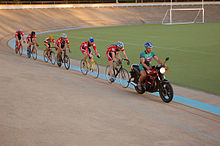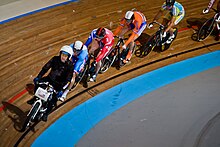Keirin
Keirin (from Japanese 競 輪 , Keirin , German "cycling race") is a discipline of track cycling . It is a Japanese variant of the sprint ; it is also known as a "combat sprint".
history
Keirin was introduced as a betting sport in Japan in 1948 ; the income from the bets was then intended for the reconstruction after the Second World War .
In 1980 Keirin was included in the program of the UCI Track World Championships for male professionals , and since 1993 the competition has been held for the men's elite category . In 2002 World Championships were also introduced for the Women Elite category .
Keirin has been an Olympic cycling competition for men since 2000 . At the 2012 Olympic Games , medals were awarded for the first time in a keirin competition for women.
Research reported by the BBC in 2008 suggests that the Japanese Keirin Foundation (JKA) paid the Union Cycliste Internationale (UCI) $ 3 million to have Keirin included in the Olympic program in the 1990s.
regulate
According to the rules of the UCI, keirin runs are usually carried out with six riders over a distance of around 1,500 meters. During the first half of the distance, a pacemaker drives on a derny or on an electrically powered bike in front of the field and slowly accelerates from about 30 km / h to a speed of about 50 km / h. After the pacemaker has left the track after 750 meters, the actual final fight begins. Depending on the number of participants, Keirin will be played in several tournament rounds. A predetermined number of participants then reaches the next round.
Keirin in Japan
In Japan, the pacemaker also uses a racing bike, with nine riders starting each run. More physical activity is also permitted than in UCI races. The drivers wear plastic armor under their colorful jerseys to protect them from falling.
Today, around 15 billion euros are turned over annually in 40,000 races in Japan and the profits, which mainly result from sports betting, are used to support the domestic bicycle industry. The races are held on 50 JKA cycle tracks with over 4000 professional drivers.
In order to avoid betting manipulation by influencing the drivers, the drivers go into retreat during the competition phase: They live in special hotels next to the velodromes and are not allowed to have physical or telephone contact with the outside world. To get a driver's license, they have to attend a ten-month “Keirin School” and take an exam. Equipment and clothing are mandatory. The drivers themselves are divided into a four-stage performance system. The so-called “International Keirin Series”, to which successful foreign racing drivers are invited, takes place every spring within the top-class races. In order to adapt to the special rules, they too have to complete the “Keirin School” with an examination for two weeks. With eleven participations, the Belgian Michel Vaarten is the foreigner with the most starts in the Japanese Keirin series. German starters have been Dieter Giebken , Michael Hübner , Sören Lausberg , Jan van Eijden , Jens Fiedler and Stefan Nimke, among others .
The ten-time Japanese professional world champion in the sprint Kōichi Nakano won the domestic Keirin series several times in a row in the 1970s and 1980s. Internationally, however, he never started in the keirin.
From 1949 to 1964, the keirin races in Japan also hosted competitions for women. In 2012, the women's competition under the title Girl's Keirin was reintroduced. The women, like the men, have to go through the keirin school. In 2014, the German driver Miriam Welte was invited to take part alongside the Spaniard Helena Casas .
Results at UCI Track World Championships
Men
Women
literature
- Kai-K. Sawabe, Bertram Job : Keirin. Opus-Verlag, Limburg 1996, ISBN 3-00-001148-X .
Web links
- Keirin Speed racers on nowness.com
- UCI regulations for track cycling, there: 3.2.14 ff. "Keirin" (English / French)
- Girl's Keirin in Japan. Tokyo Weekender, September 16, 2012, accessed April 7, 2014 .
Individual evidence
- ↑ "Cycling cash linked to Olympics" on news.bbc.co.uk , accessed on April 2, 2011 (English)
- ↑ The gear ratio on the wheels is set to <55: 12–16, cf. Kai-K. Sawabe / Bertram Job: Keirin , Limburg 1996, p. 20
- ↑ Martina Kasprzak: "You felt like you were in jail". Schweriner Volkszeitung, archived from the original on August 15, 2007 ; Retrieved December 8, 2013 .
- ↑ Achim Dreis: Bicycle license for combat sprinters. FAZ, April 3, 2014, accessed April 7, 2014 .



